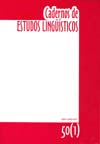Resumo
In this paper I present an argument against Levinson’s thesis according to which anaphoric relations might be fully explained by means of pragmatic principles. The thrust of my argument consists in pointing out the fact that every conversional implicature is cancellabe, a fact which, in my own view, is not properly taken into consideration in Levinson’s pragmatic approach to anaphoric relations. I draw on Levinson’s account of anaphoric relations in sentences containing a reflexive pronoun.Referências
CHOMSKY, Noam: Language and Problems of Knowledge, Cambridge (Massachusetts), MIT Press,1988.
EGLI, Urs: “Anaphora from Athens to Amsterdam”, in Reference and Anaphoric Relations, (orgs.)K.Von Heusinger e Urs Egli, Dortrecht, Kluwer, 2000.
VICTORIA, A. Fromkin, CURTISS, Susan, et alia: Linguistics: An Introduction to Linguistic Theory, Oxford, Blackwell, 2000.
GRICE, Paul: Studies in the Way of Words, Cambridge (Massachusetts), Harvard University Press, 1989.
LEVINSON, Stephen: Presumptive Meanings: The Theory of Generalized Conversational Implicature, Cambridge (Massachusetts), MIT Press, 2000.
RADFORD, A.: Transformational Syntax: A Student’s Guide to Chomsky’s Extended Standard Theory, Cambridge, Cambridge University Press, 1981.
O periódico Cadernos de Estudos Linguísticos utiliza a licença do Creative Commons (CC), preservando assim, a integridade dos artigos em ambiente de acesso aberto.

